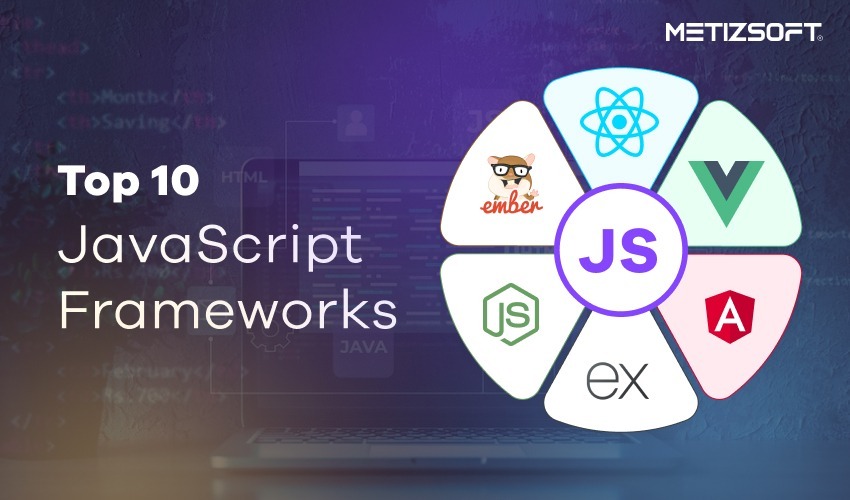
Table of Contents
Introduction
JavaScript and its never-ending offerings have given the web development community an edge in this multiplying digital landscape. Many other frameworks have come, dominated for a while, and vanished, but JavaScript frameworks continue to reign. However, choosing the proper JavaScript framework is always tedious, as the pool has many best-in-class options.
This blog post will discuss the top JavaScript development frameworks that have captured the development community’s attention and will continue to be popular in 2024.
Understanding the JavaScript Framework
A JavaScript framework is a primary collection of pre-written JavaScript code libraries that web developers can use to save time in their programming.
Developing web applications without JavaScript frameworks is possible, but utilizing frameworks can provide benefits such as pre-built templates that handle basic programming patterns. When developing applications using frameworks, it is possible to avoid writing repetitive feature code by exporting those features from the framework libraries.
JavaScript has become the foundation of dynamic websites and web-based applications, with popular JavaScript frameworks providing all the necessary aesthetic features.
Core features of JavaScript Frameworks
1. Structure – It follows specific patterns and architectures, such as Model-View-Controller (MVC), to offer a standardized way of building and organizing web applications.
2. Reusability – The framework’s code can be reused throughout an application, saving development time and effort.
3. Efficiency – A framework expedites application development by automating routine programming tasks, enabling developers to concentrate on creating unique application components.
4. Consistency — Well-organized and easily maintainable code can save time and effort in the long run.
5. Enhanced Functionality – Most JS Frameworks consist of built-in tools for routing, state management, and API interaction, simplifying the development of complex applications.
Reasons Behind JavaScript Frameworks Popularity
Enterprises and developers prioritize JS frameworks for various reasons, including:
Speed and Efficiency – JS Frameworks speed up development by providing pre-written code and functions crucial for meeting deadlines and managing complex projects.
Cross-platform Compatibility — Some JavaScript frameworks allow cross-platform development, allowing developers to create dynamic web, mobile, and desktop apps from a single codebase.
High-end Scalability – Frameworks have architectural patterns and best practices that help scale applications.
Timely Update & Improvements – Organizations or active communities typically maintain frameworks, ensuring regular updates to new features, performance improvements, and security patches. This elevates the reliability of Javascript frameworks.
Extensive Community and Ecosystem- Large, active communities support popular JavaScript frameworks with shared knowledge, resources, plugins, tools, and community support for troubleshooting and development.
Top JavaScript Framework 2024 List!
React.Js
React.js, developed by Facebook, boasts a virtual DOM feature that enables efficient and flexible rendering of UI components. It is broadly used for creating interactive user interfaces, particularly single-page applications.
Pros –
- Consistent improvement
- SEO-friendly
- Simpler syntax
- Reusable components
- Easy to learn and implement
- Rich community support
Use cases – Facebook, Instagram, Airbnb, Netflix, WhatsApp,
Vue.Js
Vue is a highly versatile JavaScript framework that is currently considered one of the most user-friendly frameworks for programmers and non-programmers. It is lightweight and adaptable and, therefore, preferred for both small-scale projects and large-scale applications. Vue is easy to learn and adapt for beginners new to website development.
Pros –
- High frontend security
- Single-file components and readability
- Easy to learn
- Robust tooling environment
- Opt for large projects
- Reactive two-way data binding
Cons –
- Smaller Ecosystem
- Community Language Barrier
- Two-way Data Binding Complexity
TezJS
TezJS is an open-source JavaScript framework that provides fast performance, scalability, code simplicity, and website speed. It is built by combining the cutting-edge Vue.js framework with the next-gen frontend tool Vite, Headless CMS, and Strapi for the backend. This combination makes it easier for developers to create websites with less configuration and a fantastic developer experience.
Pros –
- Open-source
- Fastest JavaScript framework
- Integration of two best technologies
- Zero learning curve (wow!)
- Follows serverless component-driven architecture
- 98+ core web vitals
Cons –
- Limited Adoption
- Steeper Learning Curve
- Limited Documentation & Support
Meteor.js
Meteor.js is a full-stack platform that seamlessly builds and manages real-time web and mobile applications in pure JavaScript. It’s known for its rapid development capabilities.
Pros –
- Active community
- Easy to learn
- Rapid development
- Provides several conveniences
- Same code on frontend and backend
- Custom package manager solution
Cons –
- Limited Database Support
- Testing Challenges
- Smaller Community
Aurelia.js
Aurelia JS is a contemporary open-source UI (User Interface) framework that helps software development service providers create efficient web and mobile applications. It is a non-intrusive framework, meaning you do not need to write any unique code, keywords, or tags to make it function.
Aurelia has become an invaluable resource for app developers who rely on JavaScript for their development needs. Now, all you need to do is write simple JavaScript code and execute it with Aurelia, and you will have access to more advanced functionalities than you could ever imagine.
Pros –
- Easy to add or remove any tools
- No dependencies
- Self-directed to the web standards
- Easy to work and implement
- Simple code reduction
- Convention over configuration
Cons –
- Steeper Learning Curve
- Small Community
- Tiny Ecosystem
Polymer.js
In May 2013, Google launched Polymer.js, a library that offers reusable components to make web development easier and faster. Polymer.js has web-component-based elements that enable developers to create custom, reusable elements. Due to its extensive features, Polymer.js has become one of the top JavaScript frameworks.
Pros –
- Supports gesture events
- Efficient in handling hybrid mobile app development
- One-way and two-way binding
- Cross-browser compatibility
- Provides command-line interface
- Allows for reusable widget creation
Cons –
- Limited Adoption & Community
- Steeper Learning Curve
- Mobile Performance Concerns
Backbone.js
Backbone is an MV* (pronounced “MV star”) framework that comprises Models and Views. The “C” in MVC (Model View Controller) frameworks stands for Controller, which is traditionally responsible for reacting to user inputs and relaying the message to the model or the view. However, in MV* frameworks like Backbone, the controller functionality is integrated within the view.
Pros –
- Flexible
- Easy to integrate
- Fast and light
- Emphasize modularity
- Minimalistic approach
- Versatile in nature
Cons –
- Potential for Inconsistent Architecture
- Less Active Development
- Complex Learning Curve
Angular.js
Angular.js, or AngularJS, is a structural framework primarily used for developing dynamic web applications. It is an ideal choice for building more complex and robust single-page applications.
Google maintains the AngularJS framework and addresses common challenges in single-page app development services. This framework implements HTML vocabulary on dynamic web pages, making it easy to use and understand.
Pros –
- Single page applications
- Two-way binding
- Open source
- Easier DOM manipulation
- Very testable
- Component-based architecture
Cons –
- Large Framework Size
- Limited Support
- Outdated Practices
Ember.js
Ember.js is a renowned JavaScript framework ideal for building web applications with a desktop-style user interface and experience. The framework revolves around a single-page website where all actions happen. Compared to other JavaScript frameworks, Ember.js performs well.
Pros –
- Suitable for complex frontend apps
- Minimizes DOM
- High-performance
- Own debugging tool
- URL-support
- Easy documentation
Cons –
- Potentially Overly Opinionated
- Limited Ecosystem
- Smaller Community
Svelte
Svelte is a lightweight and efficient open-source framework for creating fast and scalable web applications. It is highly responsive and ideal for real-time or data-intensive applications that function across multiple devices.
Pros –
- Easy to learn
- Excellent performance
- Client support
- Component-based model
- Smaller in size
- SEO-friendly
Cons –
- Steeper Learning Curve
- Smaller Ecosystem
- Limited Developer Experience Tools
How to Choose the Best Framework?
When choosing a JavaScript framework, you must consider the project’s specific needs and the team’s expertise. Here are those key prospects:
Project Requirements — Before choosing a framework, assessing your project’s size, complexity, and specific requirements is essential. Some frameworks, like Angular, are better suited for large-scale projects, while smaller projects can benefit from using Vue.js.
Application Types – Certain types of applications are better suited for specific frameworks. Choose your technology based on the type of app being built, such as single-page applications (SPAs), mobile apps, or real-time applications.
Learning Curve — When considering a technology project, consider your team’s familiarity with the technology. If you plan to hire developers or outsource the project, look for suitable talent who excels in this technology.
Performance — Evaluateyour application’s performance needs. Frameworks like Svelte and Vue.js are well-known for their efficiency and fast rendering.
Community & Ecosystem — A strong community and ecosystem lead to better support, more resources, and a comprehensive range of third-party tools and libraries. React and Angular, for instance, have extensive ecosystems.
Final Thoughts
If you choose to use JavaScript for web development, it’s always a good idea to consider using some popular JavaScript frameworks. These frameworks can help your development team save time and money. Understanding and familiarity with a JavaScript framework is crucial to improving your web development process.
Now that you understand JavaScript frameworks, their core features, and the top-listed JS frameworks, what is holding you back from starting your next project? Choose the one that you find suitable and partner with Metizsoft the only web development company you need for the best possible results. Contact us today!
AboutChetan Sheladiya
Related Posts
Accepting Ruby Class Methods: Class & Instance Methods in Ruby
As a programmer, you need to write Ruby classes. However, it is crucial to understand the differences between Ruby class...
Top NodeJS Frameworks to Look For in 2024!
In 2009, Node.js entered the tech stack, enabling developers to use JavaScript for server-side scripting. This framework...

